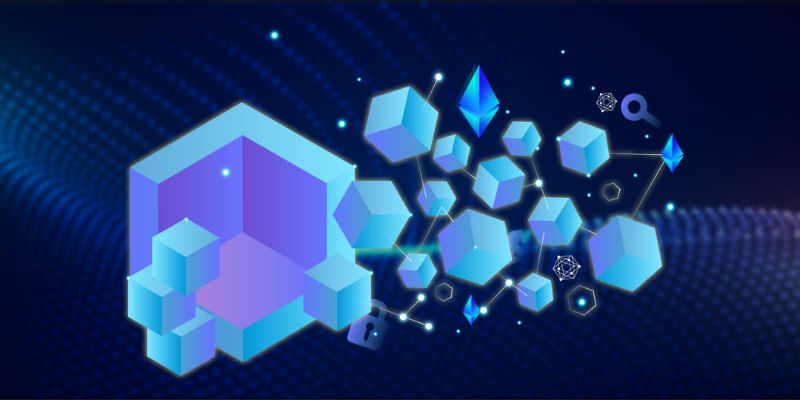Blockchain isn’t just about digital currency anymore; it’s a tech revolution on the rise. Gone are the days when its potential was a mere concept. Today, recent advances in blockchain research push the envelope, bringing us closer to a future where technology spells limitless possibility. My deep dive into the latest developments will show you how blockchain is scaling new heights, transforming finance, linking varied networks, and even securing our health data. Let’s explore these tech marvels together and see where the bits and blocks of tomorrow could lead us.
Pushing the Boundaries: Updates in Blockchain Scalability
Implementing Sharding Techniques for Enhanced Transaction Throughput
How do sharding techniques work to improve blockchain transaction speeds? Sharding splits a blockchain into smaller pieces, called “shards”, each managing its transactions and data. This means more transactions can happen at once, making everything faster.
Now, picture a busy highway. Sharding is like adding more lanes to reduce traffic jams. Imagine each lane as a shard, where cars (transactions) move smoothly without clogging the road (blockchain). As some of us dive into this, we’re creating smart ways to share data across shards safely.
Blockchain tech is evolving rapidly. Companies want to grow and handle lots of data and transactions. Sharding is our big move to break limits and speed up blockchain.
Innovations in Off-chain Solutions and Layer 2 Scaling
What are off-chain solutions, and how do they enhance blockchain scalability? Off-chain solutions handle transactions outside the main blockchain. They free up space, speed things up, and cut costs.
Think of a busy fair with long lines at every game. Off-chain solutions are like special passes that let you play games without waiting in the main line. After you’re done, the results go back to the main line. It’s a quick way to enjoy more, wait less.
Layer 2 scaling is also like a special pass. It builds new layers on top of the main blockchain. Transactions happen on these layers using less space and time. We call this layer 2 because it’s the second floor in our blockchain mall. More space means more fun, more shopping, and no overcrowding.
My pals and I work hard on these tech marvels. We want everyone to make and spend digital money without glitches. It’s about making life easier and letting businesses zoom forward. We’re tweaking and testing to make the process even better. We’re all about keeping our digital world running smooth and fast, just like your favorite video game!
These updates in blockchain scalability are breaking tech limits. They’re key to a future where our digital stuff works like magic. With every smart tweak, we step closer to a world where everyone can trust and use blockchain like a pro. It’s a thrilling ride, and the best part is, we’re just getting started!
Revolutionizing Finance: The Latest in Decentralized Finance (DeFi)
Integration of Smart Contract Advancements in DeFi Protocols
Smart contracts changed how we deal with money online. They are like usual contracts but they run by themselves. They do what they promise without anyone in the middle. The latest DeFi systems use these smart contracts to make finance work smoother.
When we put smarter contracts into DeFi, we get more secure and faster money actions. It’s like having a super quick and honest banker in your computer. These smart contracts now can handle more complex jobs. This is great for DeFi because it can do more without making mistakes.
Bridging Traditional Finance and DeFi through Innovative DApps
Now, think of traditional banks we visit. They keep your money, help you pay for things, and lend you cash. But what if we can do all this without the bank? This is where DeFi DApps come in. DApps stand for decentralized applications. These are apps that use blockchain to offer these banking services.
They link the old ways of using money with the new DeFi world. People anywhere can borrow, save, or invest without needing a real bank. It’s a big step. And it is working because of how blockchain tech grows.
Imagine lending money right from your phone to someone across the world. Or imagine growing your savings with rates higher than any bank can offer. All of this is possible with DeFi DApps. They are building bridges one block at a time to connect everyone to a new finance world.
Both smart contract upgrades and DeFi DApps are creating a future where dealing with money is easier, faster, and open to everyone. Trust in finance is no longer about people but about the code. And this code is getting better every day, making money matters less of a hassle. Welcome to the new age of finance, simplified by blockchain.
Bridging the Gaps: Advances in Blockchain Interoperability
Cross-Chain Technology: Connecting Diverse Blockchain Networks
New tech is smashing walls between blockchains, just like in cartoons. It’s like building bridges, but for online money stuff. We call it cross-chain tech. It lets different blockchains chat and swap info smoothly. Imagine you could talk to dolphins; it’s sort of like that, but for blockchains.
What cross-chain does is simple. It moves data from one place to another, even if they use different languages. Think of it as a translator at the UN, but for computer codes. This makes working with many blockchains easy, just like playing with all your friends in one big sandbox.
We now have tools that act like passport control, checking stuff as it moves from one blockchain to another. They make sure nothing shady is going on. So, you can trust the system.
Need to move your digital coins from one place to another? No sweat! Cross-chain tech joins the dots, making everything work together like a well-oiled machine. You won’t even notice the tech magic that’s happening underneath.
The Role of Decentralized Exchanges (DEXs) in a Unified Blockchain Ecosystem
Think of DEXs as the playground where all the blockchains meet up to swap stuff. They are like a giant digital swap meet, but instead of trading baseball cards, you trade digital coins and tokens.
DECs let you trade without someone in a suit taking a cut or telling you what you can or can’t do. It’s all about freedom and control, a bit like choosing your own adventure book, but with your money.
These online swap spots are key in hooking up different blockchains. They’re smashing old-school finance with new rules. It’s like having a lemonade stand, but someone in another country can buy your lemonade without even getting on a plane.
Also, they keep your secrets safe. With DEXs, you don’t have to tell them your life story just to trade some coins. They’re like the quiet kid in class who’s really good at keeping secrets.
Both cross-chain tech and DEXs are like the cool new kids on the block(chain). They’re shaking things up and making the future of online money exciting, easy, and open for everybody. It’s a pretty neat time to be in the world of blockchain, and it’s only going to get better.
Blockchain’s Impact on Healthcare Efficiency and Security
Blockchain Solutions for Secure Medical Record-Keeping
One hot topic today is how blockchain helps healthcare. Let me dive in. You know, hospitals and clinics keep a lot of patient info. It’s private and must stay safe. Blockchain is like a super-secure vault for this data. Doctors can share records fast, but only with the right people.
So, what makes blockchain good for keeping records safe? Simple. It breaks data into chunks, mixes them up, and locks them tight across many computers. Even if one computer gets hit by hackers, the rest keep the data safe. Plus, every move on blockchain gets tracked. We can always see who did what, and when.
This tech is more than just strong walls for data. It gives you power over your health info. Only you can say who sees your records and who can’t. No more worries about snooping eyes. It’s your data, and blockchain keeps it that way. Clear as day, right?
Advancements in Drug Traceability and Patient Consent Management via DLT
Now, there’s more good stuff. Drugs need to get from labs to pharmacies to you without a hitch. Blockchain makes this smooth and clean. It tells us where a drug’s been at every turn. This means no fakes, no mix-ups, and safe meds for you.
DLT, or distributed ledger tech, is what we call the brains behind blockchain. It’s what lets many computers hold the same data. When you say “OK” to a treatment or a drug, DLT puts that ‘yes’ in stone. Your ‘go-ahead’ is safe and sound, and nobody can change it.
This helps a lot with trust. You know that your ‘yes’ or ‘no’ to a drug or a test stays as you want it. No changes without your say. DLT puts you in the driver’s seat of your healthcare.
In the end, blockchain in healthcare isn’t just cool new tech. It’s a game-changer making health stuff safer and more in your hands. It’s got doctors and patients talking more, with trust as the base. We’re looking at a future where your health is protected like never before. That’s something to get pumped about!
We’ve explored exciting updates in blockchain, showing how tech leaps are making waves. From better transaction speeds through sharding to smart layer 2 strategies, we’re pushing past old limits. DeFi is turning finance on its head, mixing smart contracts and DApps to bring new tools to our money matters. We looked at how blockchains are now talking to each other, thanks to cross-chain tech and savvy DEXs. Lastly, healthcare is getting a boost from blockchain, making records safe and tracking drugs easier.
To wrap up, these advances are big news for all of us. They make things we care about — money, health, the internet — work better and safer. As we keep building and connecting with blockchain, I’m eager to see how much further we can go. It’s a thrilling time to be part of this journey, and I can’t wait to share what comes next. Stay tuned!
Q&A :
What are the most significant breakthroughs in blockchain technology lately?
Recent advancements in blockchain technology have been focused on improving scalability, interoperability, and sustainability. Layer 2 solutions like the Lightning Network and various sharding techniques are examples of scalability improvements. Cross-chain bridges and Polkadot’s parachain structure represent strides in interoperability. Furthermore, sustainability efforts are seen in the shift from Proof of Work to Proof of Stake consensus mechanisms, which significantly reduce the energy consumption of blockchain networks.
How is blockchain research evolving to enhance security and privacy?
Blockchain research is constantly evolving to enhance security through the development of more robust cryptographic algorithms and consensus protocols that can better withstand cyber-attacks. Research into zero-knowledge proofs and secure multi-party computation is advancing privacy preservation, enabling transactions to be validated without exposing sensitive data. Moreover, privacy-centric blockchains with features like stealth addresses and ring signatures are being explored to offer higher levels of anonymity.
What role does blockchain play in the development of decentralized finance (DeFi)?
Blockchain serves as the foundational technology behind the entire DeFi ecosystem. By utilizing smart contracts and decentralized applications (dApps), blockchain enables the creation of financial instruments without traditional intermediaries like banks. Recent advances in blockchain research have facilitated the development of more complex DeFi applications, offering services such as lending, borrowing, yield farming, and decentralized exchanges (DEXs) that operate with greater efficiency, transparency, and inclusivity.
How are blockchains becoming more environmentally friendly?
As concerns over the environmental impact of blockchain technology grow, research is increasingly focusing on developing more energy-efficient consensus algorithms. The most significant of these developments is the transition from energy-intensive Proof of Work (PoW) systems to Proof of Stake (PoS) or hybrid models that drastically reduce power consumption. Additionally, research into carbon offsetting and the use of renewable energy sources for mining and network operations is contributing to a greener blockchain ecosystem.
What impact have recent advances in blockchain research had on smart contracts?
Recent advances have extended the capabilities and security of smart contracts, which are self-executing contracts with the terms of the agreement directly written into lines of code. Improvements in smart contract platforms have allowed for more versatility, reduced the likelihood of bugs, and lowered transaction costs. Innovations such as upgradeable smart contracts and formal verification processes have also emerged to enhance the reliability and efficiency of smart contract deployment and execution.



